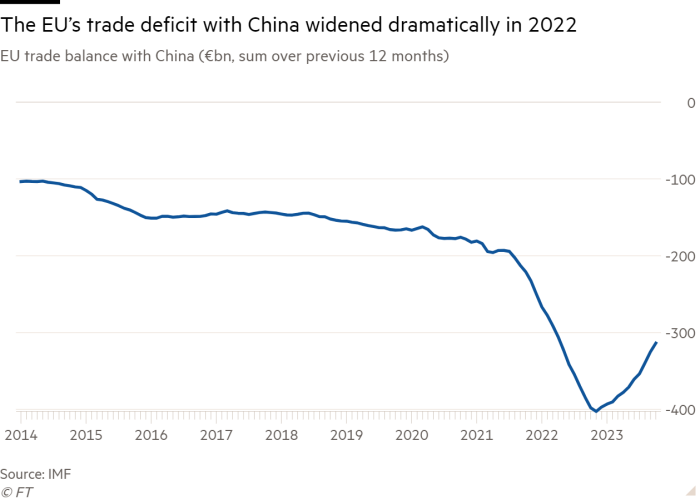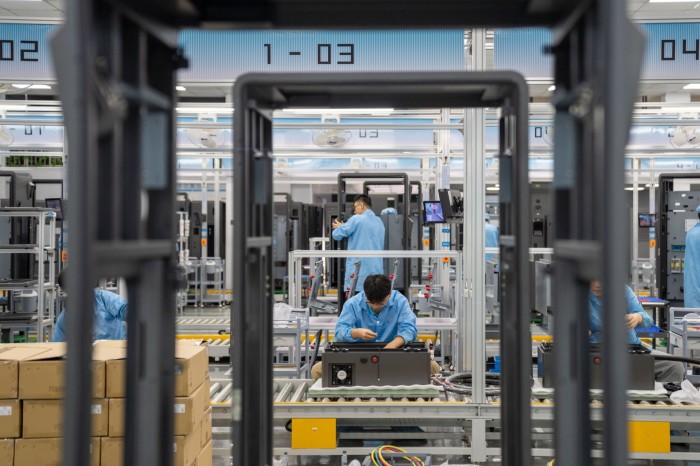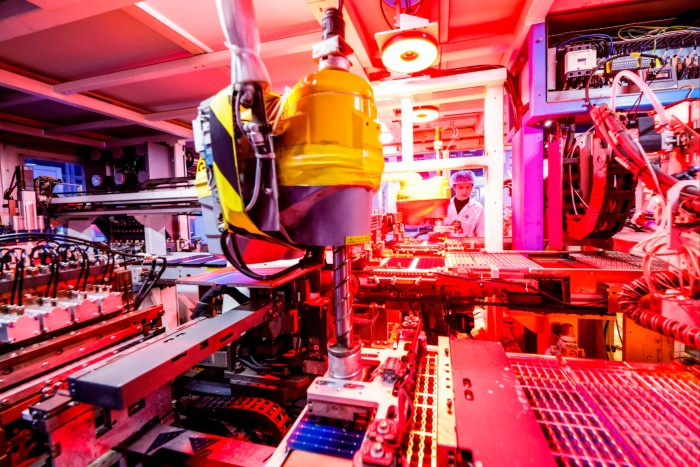In a speech that delivered China’s assessment of world trade conditions in 2024, commerce minister Wang Wentao last week warned the “environment is poor”.
“Rising trade protectionism” and “intensified geopolitical conflicts” were among the main challenges, he told reporters in Beijing on Friday.
But in China’s favour, he reassured his audience, were record exports from its “new three” industries: electric vehicles, solar energy products and lithium batteries.
The rapid growth of China’s new breed of green exports — which rose 30 per cent year-on-year to Rmb1tn ($139.3bn) in 2023, according to Wang — has boosted the world’s second-largest economy as it struggles with a deep property slump, deflationary pressure and low investor confidence.
But for its developed country trading partners, the prospect of China’s low-cost imports flooding their markets and wiping out jobs in important industries such as the automotive sector and solar and wind power is prompting growing alarm.
Later this year, the European Commission is set to conclude an anti-subsidy investigation into Chinese EV production that could lead to higher tariffs for Chinese imports. Brussels is also considering emergency support measures for its solar panel manufacturing industry, including an anti-dumping investigation. The US, meanwhile, has slapped export controls on high-technology shipments to China.

The EU and US are, to use officials’ preferred term, “de-risking” — in effect diversifying their sources of key products — and tightening investment screening for Chinese companies, essentially scrutinising transactions for national security concerns.
Beijing has attacked the EU anti-subsidy investigation into EVs as “naked protectionism” and has criticised “de-risking”. But western critics argue China’s policymaking has been mercantilist for decades, with the methodical setting of targets to increase domestic supply chain self-reliance. Foreign companies complain they are facing growing obstacles to accessing the Chinese market.
“I’m worried about this issue, that it could turn into another trade conflict between two of the most important trading partners,” says Wang Yong, professor at the School of International Studies in Peking University, referring to the EV dispute between China and the EU. “If that happens nobody will benefit,” he says, adding that China and its main trading partners need to think of “creative solutions” to avoid escalation.
But George Magnus, an associate at Oxford university’s China Centre, says trade negotiators will struggle to prevent further fallout this year.
The emergence of China’s “new three” and other industries that were developed with heavy state subsidies is bringing to a head a clash between the Chinese economic system, which closely marries state policy and financial support with an aggressive private sector, and the market-orientated capitalism of developed countries.
“What both parties want is just not really acceptable to either side,” Magnus says.
Developed countries, and those in the EU in particular, want China to dilute its industrial policies and focus on the domestic economy. Chinese leaders, meanwhile, “obviously like the idea of open trading relationships but it’s open trading relationships that are consistent with the way that they want to do industrial policy”, he adds.
Developed countries have long grizzled about Beijing’s industrial policy but for the EU the discrepancies gained urgency in 2022, when China booked a “historic” trade surplus with the bloc of nearly €400bn.
Brussels announced the anti-subsidy investigation when Chinese EVs began gaining market share last year. At the same time, the Ukraine war and the pandemic convinced European leaders they needed to diversify their sources of some key products in their supply chains, such as the rare earths, which are dominated by China.
Their actions came alongside measures in the US. As well as restricting Chinese access to advanced semiconductors and stepping up the screening of inward and outbound investments to and from China, in 2022 President Joe Biden signed the Inflation Reduction Act, which aims to strengthen America’s renewable energy manufacturing supply chain.
“We do not want to see decoupling from China,” European Commission President Ursula von der Leyen told reporters on a visit to Beijing to see President Xi Jinping in December. “What we want to see is de-risking.”
This was about “addressing excessive dependencies through the diversification of our supply chain . . . and thus increasing our resilience”, she said.
Chinese officials responded by criticising Europe’s “restrictive economic and trade policies”. China’s foreign ministry director-general for European affairs, Wang Lutong, who participated in the meetings with the EU delegation, attributed China’s industrial development to mere “innovation”.
Yet for Beijing, ambitious policies squarely aimed at reducing the economy’s reliance on foreign countries have been under way for decades.
This was originally motivated by China’s desire to catch up with its western counterparts after decades in which the economy was largely closed to world trade during Mao Zedong’s leadership. But under Xi, who has sought to become more assertive on the foreign stage, it has become a national security imperative.

“China was the original ‘de-risker’,” says Jens Eskelund, president of the European Union Chamber of Commerce in China. “It’s no secret that China has been talking about self-reliance for a very long time.”
In the early 2000s, Beijing launched several industrial plans which aimed to reduce the nation’s dependence on imported technology to 30 per cent or less by 2020.
But the plan that really worried western governments, including that of former US president Donald Trump, was “Made in China 2025”, which sought to elevate China’s technological prowess to the highest levels.
Tao Wang, chief China economist with UBS and author of Making Sense of China’s Economy, says policymakers at the time were worried about rising labour costs, a rapidly ageing population and the growth of digital technologies overseas.
“The idea was that China was facing this middle-income trap challenge,” Wang says. “And so we really needed to move up the value chain and upgrade our industry to be able to compete.”
The worrying part of Made in China from developed countries’ perspective was that accompanying documents listed ambitious market share targets across 10 strategic industries, from IT and digital machine tools to robotics, aerospace and new energy vehicles.
For instance, Chinese producers of 5G mobile network equipment and handsets should have 80 per cent domestic market share and 40-45 per cent international market share by 2025, according to analysis from the US Chamber of Commerce. To achieve similar targets, electric battery makers were offered subsidies that could account for more than 50 per cent of the cost of the product.
Foreign business groups attacked the plan as mercantilist, with the US Chamber saying it raised the “likelihood of growing inefficiencies and overcapacity in China as well as spillover distortions on a global scale”.
After outcry from western governments, culminating in Trump launching a trade war on China, Beijing gradually dropped Made in China 2025 from official discourse. Xi began instead talking about “dual circulation”, essentially trying to balance exports and domestic consumption — an equilibrium Beijing has yet to manage, economists say.
However, generous subsidies have continued to flow into many of the target sectors, from semiconductors to EVs.
The 2018 prospectus of leading EV maker Nio, for instance, mentions not only subsidies targeting consumers, which are also common in the US and EU, but government handouts for building and operating public charging stations, as well as for product development, production facilities, research and development, asset acquisitions and low-interest government loans. In 2020, Nio received a nearly $1bn bailout from state-backed investors.
China ended an 11-year consumer subsidy scheme for EV purchases in 2022. But local governments still offer subsidies and tax rebates and the central government has prolonged a tax reduction on EV purchases to 2027. CSIS, the US think-tank, has put Beijing’s cumulative state spending on the EV sector at more than $125bn between 2009 to 2021.
Importantly for China’s state planners, the sector has met its targets. Chinese brand EVs held 79.9 per cent of the domestic market in 2022, according to state media.
What has really alarmed the west about Chinese clean tech companies is that their technology is often superior to that of the US and other advanced economies.

National Security Advisor Jake Sullivan said in a speech last April that the US “had to contend with the reality that a large non-market economy had been integrated into the international economic order in a way that posed considerable challenges”.
He accused China of subsidising “at a massive scale both traditional industrial sectors, like steel, as well as key industries of the future”.
But Wang of Peking University says it would be wrong to dismiss the important role of China’s huge and dynamic private sector in the success of many industries, including EVs.
“Of course, they benefit from . . . subsidies from the different levels of government,” he says, of China’s private companies. But their innovation and entrepreneurship should not be underestimated: “They have benefited a lot from the fierce competition in China and in the world.”
One downside to such heavy-handed state intervention is that China’s industrial policies can produce unpredictable results and be prohibitively costly, analysts say.
In China’s western province of Sichuan, the Chongqing Shenhua Thin Film Solar Technology Co is one example of centralised policy misfiring.
Presiding over the solar plant’s launch ceremony in 2017, the deputy mayor of Chongqing proudly declared the Rmb2.55bn project would “usher in a new era” of clean energy industries in the western Chinese megapolis.
Today, however, the factory is a forlorn sight — abandoned by its state-backed shareholders after they decided its technology could not compete in China’s cut-throat solar cell market. The entrance turnstiles are wired shut and the German engineers who set up its advanced production lines have long gone.
“There are no new investors to kick-start the factory,” laments the lone guard at the gate.
Although China’s solar industry has grown to dominate the global market, it has also had extreme ups and downs — as the Shenhua investors found. Companies went bankrupt, for instance, after export markets contracted following the eurozone debt crisis that began in 2008.
It is a boom and bust pattern repeated in other sectors. China has struggled to develop a cutting edge semiconductor industry despite 40 years of state support.

Even the automotive industry, which was dominated by foreign-Chinese joint ventures until the EV race, was not particularly internationally competitive before the development of new energy vehicles, UBS’s Wang says.
She believes the difference with the EV sector is that the government “didn’t pick winners and protect certain incumbents and so on, but instead created incentives for people to get into the industry and then compete”. Whoever had the best strategy and the best technology won, she adds.
Despite its technological prowess, China’s EV industry has followed a trajectory similar to other sectors favoured by Beijing, says Jörg Wuttke, former president of the European Union Chamber of Commerce in China and now president emeritus.
“Everybody has an endless supply of loans and support from the local government and that’s why normally, whenever China scales up, at the end, it becomes very cheap and then it has only one rescue mechanism. That safety valve is called exports,” he says, adding it was the Chinese taxpayer who ends up footing the bill.
Historically, the initial rollout of an industrial policy has been accompanied by rules that make it hard for foreigners to participate, according to Wuttke.
“You can’t compete against an economy which in essence is always only opening up when actually the train’s already left the station,” he says.
Chinese policymakers and businessmen often see foreign complaints as sour grapes. One western executive recalls how, at a meeting of Chinese and European businesspeople in Brussels last year, an official from one of Beijing’s state-owned enterprises started lecturing the gathering on how Europe had lost its “Protestant work ethic”.
“There really seemed to be the perception right there that Europe is being lazy,” the western executive says. This was despite the fact that Europe’s productivity levels remain higher than China’s, he adds.

Chinese policymakers also point to increasing US and EU subsidies for green industry. The cost of the US Inflation Reduction Act, for instance, was originally estimated at $385bn but could eventually rise to $3tn.
“In Europe 10 or 20 years ago, and in the US, they thought if we are dealing with China, China will become more like us. But China managed to actually make us become more like them,” says Wuttke.
What is different with China’s latest round of policies, however, is the growing emphasis on national security, analysts say.
Under Xi, the Chinese government has expanded its definition of security to embrace most areas of technology, from energy and the environment to data and manufacturing, with a focus on self-reliance.
With China’s property market downturn and consumers reluctant to spend, Chinese banks are lending more to manufacturers, raising fears in Europe especially that another wave of cheap goods is about to head its way.
If the EU concludes its EV anti-subsidy probe by penalising Chinese cars, Beijing would probably retaliate, analysts say. Last year Beijing responded to US export restrictions by placing limits on shipments of two metals used in chipmaking, gallium and germanium, over which it has a chokehold. China also this month fired a warning salvo at France, which it sees as one of the protagonists of the EV dispute, by launching an anti-dumping probe into French cognac.

Henry Gao, Professor of Law at Singapore Management University, says China will do its best to avoid a breakdown in the relationship with the EU, as happened with the US under Trump. With its economy struggling and government debt rising, it cannot afford anyway to keep subsidising its EVs.
Gao says that Xi likely realises it is not wise to quarrel with too many big trading partners simultaneously. “Xi probably sees the current world through the lens of the ‘three kingdoms’,” says Gao, referring to a period of history when three states fought for supremacy in China. “You cannot fight the two other kingdoms at the same time. When you fight one you must try to be friends with the other. That is the strategy.”
For advanced economies, China’s low-cost exports and production could help governments balance inflationary pressures while transitioning to cleaner technologies. This could provide one motivation for defusing looming trade differences.
“If globally people want to adopt a green transition rapidly, it makes sense to use cheaper, more cost efficient products,” says Robin Xing, chief China economist with Morgan Stanley. “So it’s also a delicate balance. How much do you want to bring the transition forward? How much do you want to be more self-sufficient in the supply chain?”
Eskelund of the EU’s Chamber believes there is a “sweetspot” in which the two sides can benefit from the other’s competitive strengths.
“It’s in the best long-term interest of both China and Europe that we find that balance to allow both sides to play to their advantages in a way that supports the other party. But that’s not where we are today,” he says.
Additional reporting from Andy Bounds in Brussels and Edward White in Shanghai

